A study by Security.org revealed some fascinating trends in the world of NFTs. In 2021, 4.6 million users were involved with NFT items, but by 2022, that number had skyrocketed to 9.3 million people, and that's just in the USA. This growth trend isn't limited to the States either. Experts at Statista forecast that the global token consumer base will reach 19.31 million users by 2027. In addition, in 2023, revenue in the NFT industry is also expected to increase to over $1,600 million. This pushes many entrepreneurs to master a new area for profit – developing platforms for selling NFT collections.
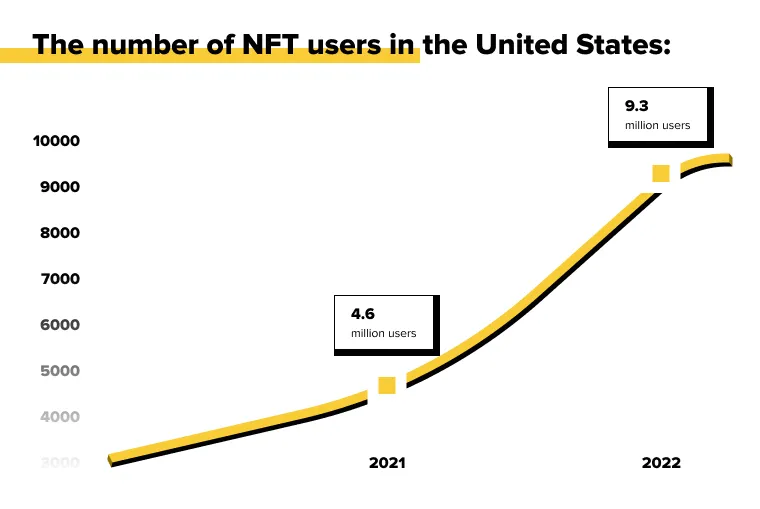
The experts at Lampa are always updated with the latest IT market trends and directions, ensuring they can offer you the best solutions for your industry. If you are considering launching your own marketplace, look at our detailed development guide. We will cover everything from preparation to tech stack selection, essential feature implementation, legal considerations, product management services, and more.
Understanding NFT Marketplaces
Before learning how to create an NFT marketplace, it's essential to understand the terms and concepts. A trading NFT platform is a digital space where users can sell and buy non-fungible tokens (NFTs). These items serve as virtual assets and are stored on the blockchain, a distributed public ledger technology. In other words, all transactions involving NFT collections are recorded as blocks for shared use and synchronization across multiple devices or networks.
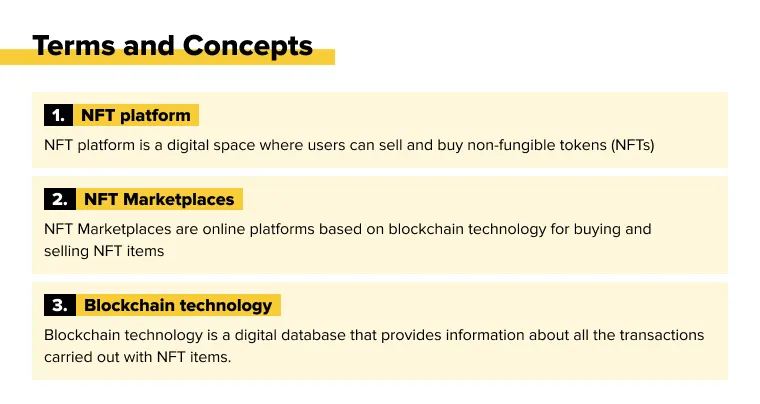
Advantages of Creating Your NFT Platform
Each token holds its unique value and cannot be exchanged for another. It also represents authenticity, integrity, and originality, serving as a certificate of authenticity and ownership rights for specific virtual items.
Building NFT marketplace comes with several benefits:
Liquidity: The demand for buying and selling virtual items is in an active growth phase, giving new markets a great chance for success and enriching their creators.
Uniqueness: NFTs are impossible to counterfeit, and their authorship can be easily verified through blockchain records. Many artists use NFTs to monetize their talents, making creating a trading platform a gateway to a loyal audience that can promote your project.
Exclusivity: Your trading platform can showcase one-of-a-kind NFT artworks, attracting experienced collectors and elevating your reputation among competitors.
Security: When you create an NFT marketplace, ensuring high security for sellers and buyers is crucial. Being a reliable intermediary will attract more users and increase the profitability of your project.
Among successful examples, we find platforms like:
OpenSea, with monthly sales volume exceeding $1 billion.
Foundation, with a turnover of over $1 billion per month.
Binance NFT, with sales volumes of $2 billion.
Rarible, with a monthly turnover of over $28 million.
As we can see, creating and successfully promoting an NFT trading project can be a highly lucrative endeavor. To grasp the intricacies of developing and launching a new token trading platform, look at the recommendations from leading experts at Lampa.
Preparing for Development
Creating an NFT marketplace is akin to software development and requires careful preparation at each stage. However, building and evolving a trading platform involves several distinctive steps.
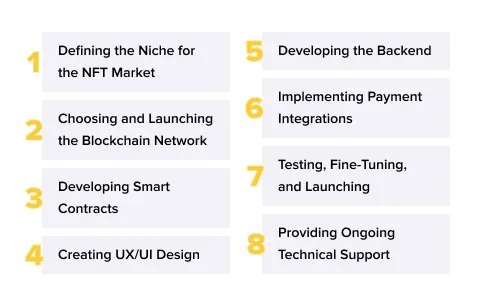
Identify the Niche and Type of Marketplace
To determine the niche for your NFT, conducting thorough market research and examining existing platforms is necessary. Let's look at the main types of trading platforms for token realization:
NFT art marketplace, where various art pieces are showcased in virtual form.
Gaming NFT platforms, where users can buy or sell collectible in-game items, character avatars, equipment, etc.
Universal trading platforms with diverse digital items (art samples, sports collections, clothing, virtual world souvenirs, etc.).
You have the freedom to come up with a unique direction for token trading since practically anything can be transformed into a digital format. Additionally, to create an NFT marketplace, you need to decide its type, which comes down to two options:
Open marketplace, where any user can list their virtual collectibles. However, this makes it nearly impossible for the owner to control the quality and type of NFTs presented.
Closed NFT marketplace, available only to selected NFT artists after a vetting process. Such a platform allows you to gather a more niche audience for your chosen artistic direction and showcase high-quality items.
Compile a List of Features
An NFT marketplace for trading items requires standard (mandatory) and additional features. The mandatory list includes:
Login/Logout/Registration and password recovery/change option.
Profile settings – name, avatar, biography, interests.
Payment process – choosing payment methods, connecting wallets, selecting currency.
Card verification option for conducting transactions.
Creating listings for NFTs.
Editing deals, including deleting/changing bids.
Minting NFTs with the ability to add descriptions, photos, videos, prices, etc.
Search with filtering options by price, NFT artist name, and tags.
Additionally, there must be features for administrators to control the marketplace internally. These include updating author status, featuring top artists, deactivating/suspending suspicious users, curating deals, and more.
As for the optional features, you can create the following:
User communication chat.
Event/auction calendars.
Video calls.
Sellers/buyers ratings.
After identifying the niche for your NFT and analyzing the interests of your target audience, consider including unique auxiliary features in your development. These additional functions will facilitate interactions between your clients and the online platform. They can serve as a tool to stand out among competitors, branding your marketplace as an exclusive project.
Choose the Blockchain and Smart Contract Development Technology
The backbone of any marketplace is a blockchain network responsible for recording, storing, and providing information on all transactions. Among the most popular blockchains are Binance Smart Chain and Ethereum. You can also create an NFT marketplace supporting multiple technologies simultaneously.
Selecting a suitable option can be challenging and time-consuming as numerous blockchain platforms are available for building an NFT project. Moreover, your choice will impact the security of your users' transactions, directly affecting their loyalty to your trading platform.
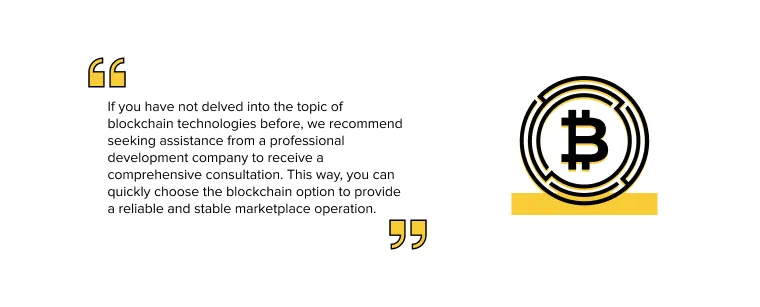
In the NFT space, a smart contract serves as the digital equivalent of a traditional paper contract. It is also essential for creating tokens. When developing a smart contract, specific buying and selling conditions (algorithms) are embedded in it, and the successful execution of these conditions validates the transaction. Subsequently, the record of this transaction is added to the blockchain code and can no longer be altered or deleted.
Choosing the Right Technology Stack
In the early stages of development, once you have identified your niche, the next step is to choose the right tech stack. The tools for creating a marketplace should meet all your needs and expectations. So, let's look at the main blockchain platforms on which token-selling platforms are built.
Ethereum
The most popular blockchain for creating NFT art and NFT markets. It features smart contract technology, which allows for self-executing contracts. Ethereum's advantages include high security and transparency for developed NFT applications. Additionally, the blockchain has an extensive ecosystem of developers, making it easier to find specialists if you want to build a marketplace on Ethereum.
Binance Smart Chain
A relatively new technology gaining traction among NFT developers. As this blockchain platform was developed by the popular cryptocurrency exchange Binance, Binance Smart Chain has a large user base. Its benefits include high compatibility with other blockchain networks, relatively low development costs, speed, and transaction fees.
Flow
This blockchain platform was designed for working with various virtual assets. Specialists and NFT enthusiasts highly value Flow for its high performance and scalability, user-friendly development environment, and compatibility with other blockchains. It's an excellent choice for creating NFT applications.
Whether you aim to create a universal or art NFT marketplace, selecting the right blockchain platform is crucial in ensuring the platform's smooth operation and user convenience.
Additionally, the tech stack includes programming languages used for writing smart contracts. Developers commonly use Python, JavaScript, Pascal, Haskell, and Solidity to create self-executing contracts on the Ethereum platform.
Designing the User Interface and User Experience
How to create NFT marketplace that easily captures consumers' attention? The answer is quite simple: develop an intuitively understandable and visually appealing User Interface (UI). To achieve this, your digital product should have clearly defined buttons, a font that is easy to read, a pleasant color scheme, user-friendly interaction with NFT details, and more.
Equally important is creating a convenient User Experience (UX) that governs the client's interactions within the application. The UX should be designed to allow sellers/buyers to perform desired actions quickly and without cumbersome transitions between sections or screens of the marketplace. Here are some tips for developing an effective UX:
Study the interests and needs of your target audience to meet their design expectations.
Structure content using visual effects and highlight key elements on screens.
Use familiar and official fonts that users are accustomed to.
Employ standard approaches for button placement and input fields to avoid confusing clients.
Integrate original design solutions while maintaining text readability.
Pay attention to flexible multi-platform NFT projects that can function on mobile and desktop devices. Developing a trading platform with responsive design will expand your capabilities to reach and engage a larger user base. This approach also ensures personalized service, as the platform will display and function correctly on the user's preferred device.
Developing the Marketplace Backend
The backend is the invisible part of your NFT art marketplace that handles information processing on the server side. It also ensures seamless operation and quick response to any actions by sellers/buyers. The components of the server system include:
Servers: required for secure storage of users' digital assets.
Databases: necessary for collecting, storing, and processing NFT metadata, transaction records, customer information, and more.
API connections: establish a stable link between the external interface and internal structure, as well as with payment systems and other third-party resources.
The backend development is structured to allow your project to scale easily when needed. Each component should efficiently perform its function to ensure high user data protection and take timely security measures to handle large transaction volumes.
Additionally, you need to design a user-friendly architecture of an NFT marketplace. It consists of both core and third-party components. The core components include:
NFT application
Wallet
Metadata (characteristics and properties of NFT)
IPFS (InterPlanetary File System)
Smart contracts
Blockchain
Third-party components may include tools for market price tracking, online calculators, services for blockchain access, and more.
Implementing Payment Integration
During development, you must integrate with various cryptocurrency wallets and fiat gateways. Here arises the question of how to make an NFT marketplace that maximally protects user finances. To achieve this, you should only use proven payment gateways. Let's consider the most commonly used cryptocurrency wallets for NFT trading, favored by consumers and marketplace owners:
Metamask
MathWallet
Coinbase Wallet
Trust Wallet
Enjin
For user convenience, you can also integrate fiat gateways. They enable the purchase of cryptocurrencies using credit or debit cards, which can then be used to acquire NFT art.
Implementing NFT Minting and Listing
To make your project more appealing to potential users, implement a feature in your marketplace for creating and minting an NFT collection, including metadata and tokenization.

To build your own NFT on the blockchain, you need to use token standards that ensure the asset functions properly and achieves functional compatibility with other components.
Familiarize yourself with the key tokenization industry standards:
ERC-721: This standard is used for identifying specific objects based on Ethereum. It is compatible with smart contracts and uses the "transferFrom" method to transfer digital assets.
ERC-1155: This identifier works with a class of assets, allowing the creation of NFT collections with multiple items. With this standard, you only need to write one smart contract for a set of assets and specify their quantities.
Additionally, the marketplace gains greater chances of success with a simple NFT listing feature, which allows users to put up all their virtual items for sale. Each listing should be editable, making changing prices or bids in auctions easy.
Implementing Community and Social Features
To popularize your NFT project, you can integrate social media elements into it. For example, user profiles, comments, chats, likes, ratings, etc. All of these features will allow buyers and sellers to communicate with each other and establish mutually beneficial relationships, leading to increased usage of your marketplace.
Social features contribute to creating a strong community around your NFT platform, which is crucial for its popularity and attracting new users. Additionally, integrating the marketplace with forums and chats like Discord, where NFT enthusiasts gather, will play a significant role in its promotion.
Testing, Launching, and Scaling
How to build an NFT marketplace to make sure it is reliable? Conduct thorough testing of each component, API connections, and other project elements. Using manual and automated testing, NFT developers can identify and rectify issues early with minimal financial and time investments. This will guarantee a timely digital product launch and provide customers with a seamless NFT trading tool.
Once your NFT art marketplace is ready to onboard its first users, you need to focus on marketing strategies and PR campaigns. Create accounts on popular social media platforms or an NFT website to help people learn more about you and your project. It is also essential to establish partnerships with influencers. You can arrange promotional integrations with bloggers followed by token collectors to attract an interested audience.
Your work on the project does not end after the release. Successful projects often require updates, scaling, and implementing new features. Experienced developers always offer technical support after the launch to ensure the project keeps up with the times.
Legal and Compliance Considerations
Another essential factor for the successful operation of your NFT marketplace is compliance with all legal norms and regulations. Familiarize yourself with key legal aspects that need to be taken into account:
Copyright: Non-fungible tokens retain the creator's copyright upon sale, and buyers may not always understand the rights they acquire. Sellers may unintentionally relinquish their authorship during transactions.
Intellectual Property Rights: In the NFT agreement, it is essential to specify conditions related to publication, royalties, or commissions from future resales. The rights holder, who possesses exclusive rights, can block, delete, or restrict NFT demonstrations at any time.
Licensing: Market participants may have licenses, including options for transferring copyright (for commercial or personal use, sublicensing, etc.).
As some countries' marketplaces may fall under Anti-Money Laundering (AML) and Know Your Customer (KYC) regulations, you may need to implement identity verification and transaction tracking processes in compliance with these regulatory requirements.
It is crucial to consider all these legal nuances while developing your trading platform to avoid unpleasant incidents and establish a reputation as a reliable NFT marketplace.
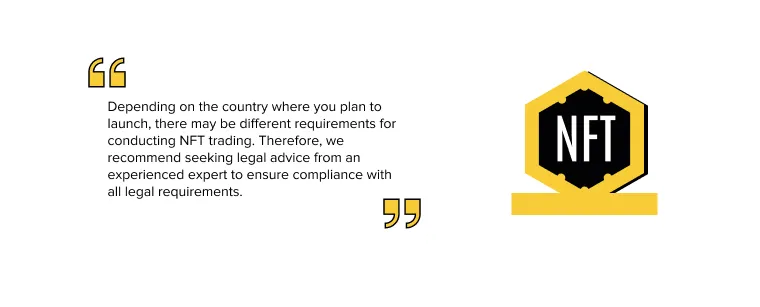
Conclusion
You have familiarized yourself with how to create an NFT marketplace and learned more about each stage of development. To obtain a seamlessly functioning digital product, it is essential to carefully select the niche for your NFT, determine the type of marketplace, create a list of mandatory and auxiliary features, choose the blockchain platform and technology stack, conduct testing, develop a marketing strategy, and adhere to legal norms.
Does it seem like there's too much to do? The experts at Lampa Software are always ready to assist you and take on all responsibilities for developing your new NFT space.